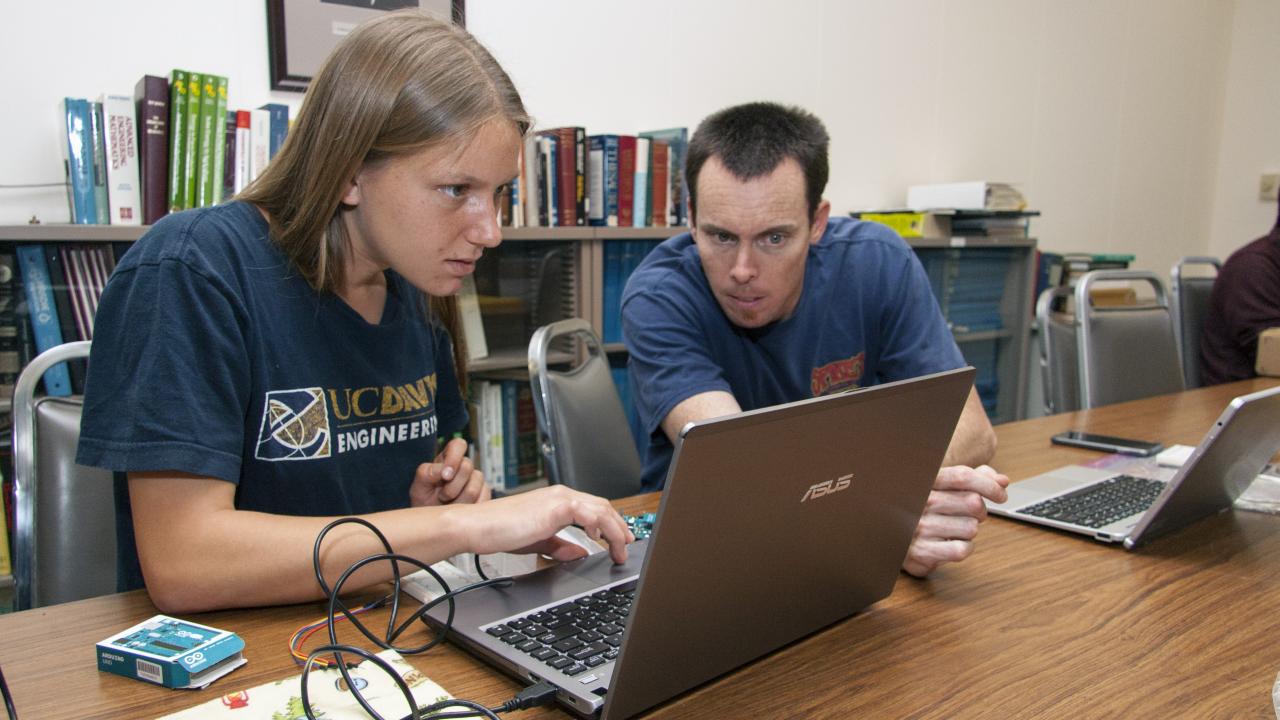
Verizon project provides a cutting-edge learning experience
Students create new tools that could make irrigating crops more efficient
More than a half century ago, UC Davis researchers invented a mechanical harvester and specially bred tomato that revolutionized the processing tomato industry. Today, a new generation of scientists is developing innovative technologies to help farmers grow crops like this more efficiently.
Faculty and students from the Department of Biological and Agricultural Engineering and the Department of Plant Sciences, with support from the cellular technology firm, Verizon, worked intensively during the 2016 growing season with sensor and communications technology to predict crop water needs for processing tomatoes—one of California’s top 10 commodities. Students gained valuable hands-on experience working with new technologies for sustainable food production.
Students identify goals
Students on an engineering team wired up a suite of sensors to an “Arduino” programming chip that would enable them to monitor and measure leaf temperature, incident radiation, air temperature, soil temperature, wind speed, and relative humidity.
“Our main challenge was to update the existing sensor for monitoring crop water stress,” said biological systems engineering student Kelley Drechsler. “We wanted to add an additional feature—remote sensing using a wireless sensor.”
“We were looking at what cluster of signals define a plant stress scenario,” said plant science team member Andrew Tom, an environmental science and management student. “Treated” plants in a greenhouse were stressed with reduced irrigation. Unstressed plants received normal amounts of water.
Shrinivasa Upadhyaya, a UC Davis biological and agricultural engineering professor, previously developed a leaf monitor that provides plant-stress data to help orchard and vine growers optimize irrigation management decisions. “That worked quite well for almonds, walnuts, and grapes,” he said. “We’ll see whether it works in the case of field crops like tomatoes.”
Students also measured the level of water tension in the tomato plants with a device called a pressure chamber or “pressure bomb.” This device is routinely used to guide irrigation management decisions in tree and vine crops, but requires direct leaf sampling and measurement in the field. New sensor technology may allow automated and remote measurement of crop water stress.
“Anything that can help automate this in the world of IOT (Internet of Things) will make life simpler,” said Kevin Welsh, with Verizon Enterprise Solutions. “These real-world cases and studies coming out of the university help validate the technology. That’s very exciting for us.”
“What growers are really interested in is accuracy,” added Moiz Badri, a solutions architect with Verizon Wireless. “They’re used to going out there and trusting their own instincts. Now they may be able to rely on new technology.”
Taking it to the field
The engineering team built an adjustable, raised platform so infrared sensors could be attached and take readings of the plant surfaces and surrounding soil below. “Ultimately, the difference in the plant surface temperature and the ambient air temperature will be what we use to determine plant stress,” said Alex Schramm, another biological systems engineering student.
“In the field of view there will be some sunlit leaves, some shaded leaves, some sunlit soil and some shaded soil,” Upadhyaya said of the challenge facing the students. “They need to discriminate between those four different features in the image.”
The engineering team determined that about 20 percent of the infrared reading was due to green plant surfaces. Used together with the calculated leaf temperature and ambient air temperature, that gave them a value to gauge plant response and crop water status.
Application of this technique to other crops depends on knowledge of crop biology, points out plant sciences professor Ken Shackel, the other faculty leader on the project. “In almonds, walnuts, and grapes, we have already had many years of experience using the pressure chamber to measure stress and then determining what that translates into in yield or quality,” he said. “Some crops are better known—like cotton and tomatoes—but for many others we just don’t have the information. It’s going to be a question of getting useful, actionable information.”
Valuing the Verizon project
Students successfully completed their research and field tested the sensor suite in a campus tomato field. More research is needed before this technology could be commercially deployed.
The Verizon project gave a dedicated group of undergraduate students a real-world opportunity to experiment with technology to make crop irrigation more efficient. And it also gave them other valuable lessons.
“I’ve learned a lot about teamwork and a lot about coordinating interdisciplinary work between people who work on very different things,” Tom said. “We are so privileged to be at a premier research university. As students, it’s in our best interest to jump at all those hidden opportunities that we don’t see every day.”